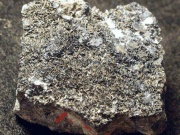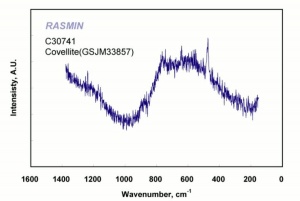Difference between revisions of "Covellite"
Jump to navigation
Jump to search
(username removed) |
|||
| (3 intermediate revisions by 2 users not shown) | |||
| Line 2: | Line 2: | ||
== Description == | == Description == | ||
| − | Dark blue hexagonal crystals or black powder composed of [ | + | Dark blue hexagonal crystals or black powder composed of [[copper sulfide]]. Covellite was named for Niccolo Covelli after he discovered the mineral at Vesuvius in the early 19th century. Copper sulfide was probably used as a black pigment in antiquity (Orna et al 1980). It is currently used in antifouling paints and in textile dying with [[aniline black]]. |
== Synonyms and Related Terms == | == Synonyms and Related Terms == | ||
copper sulfide; covelliet (Ned.) | copper sulfide; covelliet (Ned.) | ||
| + | [[[SliderGallery rightalign|covelliteRS.jpg~Raman]]] | ||
| − | + | == Risks == | |
| + | |||
| + | * Unstable in air. | ||
| − | == | + | ==Physical and Chemical Properties== |
| − | Hexagonal crystals. Cleavage is perfect in one direction. Fracture = uneven. Luster = submetallic. Streak = gray to black | + | * Hexagonal crystals. |
| + | * Cleavage is perfect in one direction. | ||
| + | * Fracture = uneven. | ||
| + | * Luster = submetallic. | ||
| + | * Streak = gray to black | ||
{| class="wikitable" | {| class="wikitable" | ||
| Line 23: | Line 30: | ||
|- | |- | ||
! scope="row"| Density | ! scope="row"| Density | ||
| − | | 4.6-4.8 | + | | 4.6-4.8 g/ml |
|} | |} | ||
| − | == | + | ==Resources and Citations== |
| − | |||
| − | |||
| − | |||
| − | |||
| − | + | * M.V.Orna, M.J.D.Low, N.S.Baer, "Synthetic Blue Pigments: Ninth to Sixteenth Centuries. I. Literature" ''Studies in Conservation'', 25:53-63, 1980. | |
| − | + | * Mineralogy Database: [http://www.webmineral.com/data/Covellite.shtml Covellite] | |
* C.W.Chesterman, K.E.Lowe, ''Audubon Society Field Guide to North American Rocks and Minerals'', Alfred A. Knopf, New York, 1979 | * C.W.Chesterman, K.E.Lowe, ''Audubon Society Field Guide to North American Rocks and Minerals'', Alfred A. Knopf, New York, 1979 | ||
| − | * Wikipedia | + | * Wikipedia: http://en.wikipedia.org/wiki/Covellite (Accessed Sept. 7, 2005) |
[[Category:Materials database]] | [[Category:Materials database]] | ||
Latest revision as of 13:38, 6 July 2022
Description
Dark blue hexagonal crystals or black powder composed of Copper sulfide. Covellite was named for Niccolo Covelli after he discovered the mineral at Vesuvius in the early 19th century. Copper sulfide was probably used as a black pigment in antiquity (Orna et al 1980). It is currently used in antifouling paints and in textile dying with Aniline black.
Synonyms and Related Terms
copper sulfide; covelliet (Ned.)
Risks
- Unstable in air.
Physical and Chemical Properties
- Hexagonal crystals.
- Cleavage is perfect in one direction.
- Fracture = uneven.
- Luster = submetallic.
- Streak = gray to black
| Composition | CuS |
|---|---|
| Mohs Hardness | 1.5 - 2.0 |
| Density | 4.6-4.8 g/ml |
Resources and Citations
- M.V.Orna, M.J.D.Low, N.S.Baer, "Synthetic Blue Pigments: Ninth to Sixteenth Centuries. I. Literature" Studies in Conservation, 25:53-63, 1980.
- Mineralogy Database: Covellite
- C.W.Chesterman, K.E.Lowe, Audubon Society Field Guide to North American Rocks and Minerals, Alfred A. Knopf, New York, 1979
- Wikipedia: http://en.wikipedia.org/wiki/Covellite (Accessed Sept. 7, 2005)

